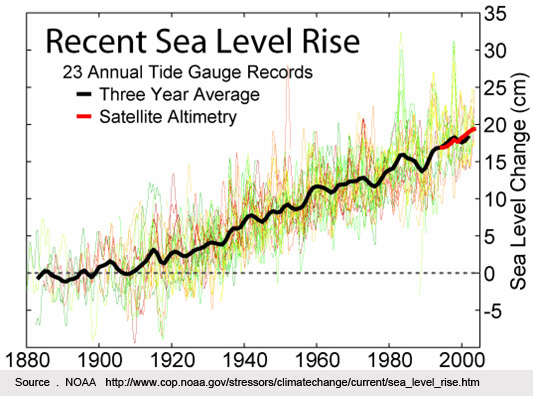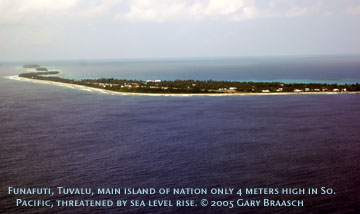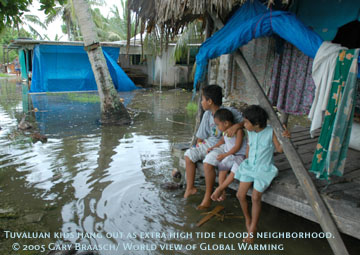- Joined
- Jan 3, 2009
- Messages
- 2,605
- Points
- 0
Indian Ocean sea level rise threatens millions
By David Fogarty, Climate Change Correspondent, Asia
SINGAPORE | Wed Jul 14, 2010 3:05am EDT
They found that sea-level rise is particularly high along the coastlines of the Bay of Bengal, the Arabian Sea, Sri Lanka, Sumatra and Java and that these areas could suffer rises greater than the global average
(Reuters) - Sea levels are rising unevenly in the Indian Ocean, placing millions at risk along low-lying coastlines in Bangladesh, Indonesia and Sri Lanka, scientists say in a study.
Researchers from the University of Colorado and the National Center for Atmospheric Research say the rising sea levels are caused in part by climate change and are triggered by warming seas and changes to atmospheric circulation patterns.
In his acceptance speech for the Nobel Peace Prize last year, President Barack Obama warned that if the world does nothing to confront climate change, "we will face more drought, famine and mass displacement that will fuel more conflict for decades".
The authors of the latest study say hig(Reuters) - Sea levels are rising unevenly in the Indian Ocean, placing millions at risk along low-lying coastlines in Bangladesh, Indonesia and Sri Lanka, scientists say in a study.
Researchers from the University of Colorado and the National Center for Atmospheric Research say the rising sea levels are caused in part by climate change and are triggered by warming seas and changes to atmospheric circulation patterns.
In his acceptance speech for the Nobel Peace Prize last year, President Barack Obama warned that if the world does nothing to confront climate change, "we will face more drought, famine and mass displacement that will fuel more conflict for decades".
The authors of the latest study say higes greater than the global average.
But they also found that sea levels are falling in other areas. The study indicated that the Seychelles Islands and Zanzibar off Tanzania's coast show the largest sea-level drop.
WARM POOL
"Global sea level patterns are not geographically uniform," said co-author Gerald Meehl of NCAR in Boulder, Colorado.
The study is published in the latest issue of the journal Nature Geoscience.
A key player in the process is the Indo-Pacific warm pool, a large oval-shaped area spanning the tropical oceans from the east coast of Africa to the International Date Line in the Pacific.
The pool has warmed by about 0.5 degrees Celsius (1 degree Fahrenheit) over the past 50 years, primarily because of mankind's greenhouse gas emissions. The warmer water has strengthened two major atmospheric circulation patterns that have a major impact on sea levels.
"Our new results show that human-caused atmosphericoceanic circulation changes over the Indian Ocean, which have not been studied previously, contribute to the regional variability of sea-level change," the researchers say in the study.
The two main wind patterns in the region are the Hadley and Walker circulations.
In the Hadley circulation, air currents rise above strongly heated tropical waters near the equator and flow poleward at upper levels, then sink to the ocean in the subtropics and cause surface air to flow back toward the equator.
The Walker circulation causes air to rise and flow westward at upper levels, sink to the surface and then flow eastward back toward the Indo-Pacific warm pool.
Strengthening of these two patterns could have far-reaching impacts on AsianAustralian monsoons, Indonesian floods and drought in Africa, the study says.
By David Fogarty, Climate Change Correspondent, Asia
SINGAPORE | Wed Jul 14, 2010 3:05am EDT
They found that sea-level rise is particularly high along the coastlines of the Bay of Bengal, the Arabian Sea, Sri Lanka, Sumatra and Java and that these areas could suffer rises greater than the global average
(Reuters) - Sea levels are rising unevenly in the Indian Ocean, placing millions at risk along low-lying coastlines in Bangladesh, Indonesia and Sri Lanka, scientists say in a study.
Researchers from the University of Colorado and the National Center for Atmospheric Research say the rising sea levels are caused in part by climate change and are triggered by warming seas and changes to atmospheric circulation patterns.
In his acceptance speech for the Nobel Peace Prize last year, President Barack Obama warned that if the world does nothing to confront climate change, "we will face more drought, famine and mass displacement that will fuel more conflict for decades".
The authors of the latest study say hig(Reuters) - Sea levels are rising unevenly in the Indian Ocean, placing millions at risk along low-lying coastlines in Bangladesh, Indonesia and Sri Lanka, scientists say in a study.
Researchers from the University of Colorado and the National Center for Atmospheric Research say the rising sea levels are caused in part by climate change and are triggered by warming seas and changes to atmospheric circulation patterns.
In his acceptance speech for the Nobel Peace Prize last year, President Barack Obama warned that if the world does nothing to confront climate change, "we will face more drought, famine and mass displacement that will fuel more conflict for decades".
The authors of the latest study say higes greater than the global average.
But they also found that sea levels are falling in other areas. The study indicated that the Seychelles Islands and Zanzibar off Tanzania's coast show the largest sea-level drop.
WARM POOL
"Global sea level patterns are not geographically uniform," said co-author Gerald Meehl of NCAR in Boulder, Colorado.
The study is published in the latest issue of the journal Nature Geoscience.
A key player in the process is the Indo-Pacific warm pool, a large oval-shaped area spanning the tropical oceans from the east coast of Africa to the International Date Line in the Pacific.
The pool has warmed by about 0.5 degrees Celsius (1 degree Fahrenheit) over the past 50 years, primarily because of mankind's greenhouse gas emissions. The warmer water has strengthened two major atmospheric circulation patterns that have a major impact on sea levels.
"Our new results show that human-caused atmosphericoceanic circulation changes over the Indian Ocean, which have not been studied previously, contribute to the regional variability of sea-level change," the researchers say in the study.
The two main wind patterns in the region are the Hadley and Walker circulations.
In the Hadley circulation, air currents rise above strongly heated tropical waters near the equator and flow poleward at upper levels, then sink to the ocean in the subtropics and cause surface air to flow back toward the equator.
The Walker circulation causes air to rise and flow westward at upper levels, sink to the surface and then flow eastward back toward the Indo-Pacific warm pool.
Strengthening of these two patterns could have far-reaching impacts on AsianAustralian monsoons, Indonesian floods and drought in Africa, the study says.



